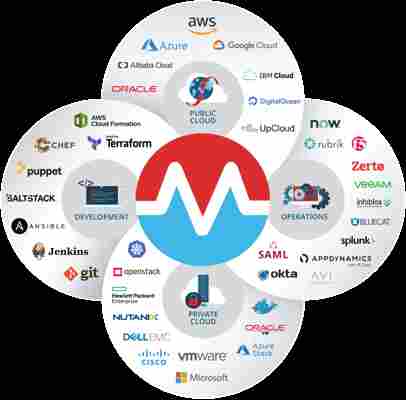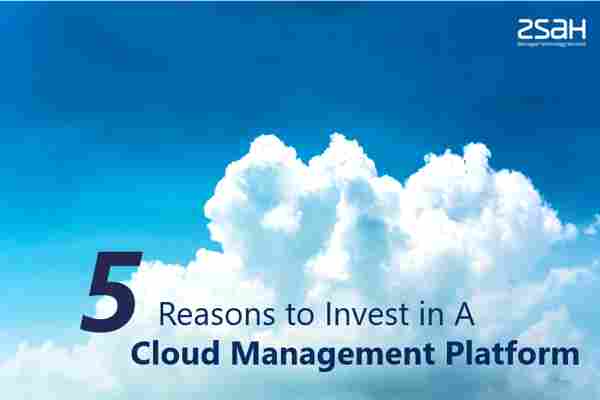Hybrid Cloud Management - Picking the best platform
Hybrid cloud management software requirements

have changed a lot in recent years
Finding the best hybrid cloud and multi cloud management software platform for your workloads can be hard. Legacy cloud management software was trying to solve a governance problem for IT Ops while others were focused on optimizing public cloud spend. The world has moved on but many CMPs are still out there trying to solve yesterday’s problems.
Morpheus is different; we were designed by DevOps pros as part of application factory that needed agility, flexibility, and control. They couldn’t find the perfect tool so they built one. It’s why we combine the industry’s best cloud management with open container orchestration and powerful infrastructure automation.
Full stack cloud management beats complex cloud bolt-ons Experts like Gartner and Forrester look at how well hybrid cloud management solutions can eliminate tool sprawl and cover use cases across many functional areas. Below are 5 areas to look at when picking the best platform for your needs. It’s key to grade vendors on how well they provide a unified approach versus forcing you to cobble together disconnected products.
STEP 1: Build and manage hybrid cloud CloudOps and platform engineering teams must quickly connect hypervisors, networks, storage, and other technologies to create private clouds. At the same time they need to manage public cloud accounts. Look for solutions that integrate with your existing technologies without needing a ton of scripting or extra costs for plug-ins. LEARN MORE
STEP 2: Consume hybrid cloud via self-service The goal of self-service IT is to give users resources on demand without worrying about the underlying technology stack. The best hybrid cloud management platform should provide self-service that meets different user needs across traditional and cloud-native platforms using GUI, ITSM, API/CLI, or Infrastructure-as-Code triggers. LEARN MORE
STEP 3: Assure hybrid cloud governance and control Speed should not come at the expense of security and process. The best hybrid cloud management platform should enable SecOps to apply control over cloud use, application provisioning, compliance policy, and security posture. This includes the ability to integrate with identity management providers and CMDB repositories. LEARN MORE
STEP 4: Automate hybrid cloud apps and infrastructure Legacy CMPs fell short when it came to meeting DevOps needs. The best hybrid cloud management platform solve this by exposing full-fidelity APIs, integrating into pipeline tools like Jenkins, supporting infrastructure automation blueprint technologies such as Terraform, and managing day-2 activities for feedback loops. LEARN MORE
What is a Cloud Management Platform? How to Choose the Best?
Cloud Management Platform (CMP) provides cloud consumer a way to manage the cloud computing products and services across multiple cloud infrastructures, including both public and private cloud. Gartner says Cloud Management Platforms are integrated products that provide for the management of public, private and hybrid cloud environments.
The minimum requirements for CMP offerings Gartner sets as "products that incorporate self-service interfaces, provision system images, enable metering and billing, and provide for some degree of workload optimization through established policies."
Capabilities of a Cloud Management Platform (CMP)
1. Self-service
Cloud Management Platform should support self-service cloud fulfillment and administration capabilities.
2. Service Catalogs
The Cloud Management Platform should present a catalog of target cloud environment services available for the organization users. Users will have access to a defined set of services or they can configure it as per the need.
3. Resource Management
A Must have for CMP is the ability to provide cloud resources visibility of virtual resources and on-demand services delivery. Following are the capabilities needed to manage resources efficiently:
Discovery of cloud resources for effective resource management and maintain an inventory on an ongoing basis.
Must be able to apply tags to cloud resources for effective resource management.
The platform should support provisioning and de-provisioning of cloud resources.
Orchestration – Automate processes needed to manage cloud resources.
Support for Migration including shifting workload from private to public cloud.
4. Governance
Hybrid cloud services must be managed in accordance with organization policies. Governance capabilities in CMP enable an administrator to manage critical business processes and automate tasks using defined rules. It also enforces policy-based control of cloud resources.
5. Financial Management
Automating rating, metering, billing of services, chargeback reports or invoicing of consumptions and third party settlement processes are critical capabilities of a Cloud Management Platform. Accurate, real-time analysis and reporting along with predictive analytics is required to contain cost.
6. Security
Security features in a cloud management platform include encryption management that extends to key management and certificates associated with encryption capabilities, role-based access control, user authentication and authorization against different identity providers etc.
7. Integration
Integration is another aspect to look for in a cloud management platform. The platform, for example, needs to support access to IT systems, billing systems, reporting and monitoring tools etc.
8. Reports and Dashboards
Many cloud management platforms provide cost management dashboards that can monitor real-time resource consumption and provide cost modeling and metrics, visibility and control over performance, availability, and capacity utilization. Granular view of cloud usage via interactive cost analytics dashboards and holistic recommendations helps to optimize the cloud cost.
5 Reasons to Invest in A Cloud Management Platform
Ever wonder why there's a trend in adopting a cloud management platform?

Cloud computing has been one of the fastest-growing segments of IT spend for some time now. Over the next four years, the ongoing cloud shift is expected to accelerate further and attract nearly 45% of IT expenditure away from traditional solutions. The impact and the after-effects of COVID-19 are only expected to add further momentum to this trend.
As cloud computing becomes the new normal for enterprise IT, multi-cloud has emerged as the preferred model for cloud adoption and deployment. One 2020 State of the Cloud study found that a significant majority of companies had opted for either a multi-cloud strategy (93%) or a hybrid cloud strategy (87%) with average usage at 2.2 public and 2.2 private clouds.
Gartner predicts that cloud strategy at more than 75% of all midsize and large organisations will either be multi-cloud or hybrid.
The multi-cloud model offers a range of benefits including access to best-in-breed solutions, risk mitigation, portability & interoperability, cost & compliance management, and the need to reduce vendor dependency, to name just a few.
However, this approach also introduces more complexity into enterprise IT environments and creates new challenges in terms of interconnecting, integrating and orchestrating across a disparate and heterogeneous system comprising multiple public and private clouds and traditional IT.
As a result, there is now a rapidly evolving cloud management platform market gearing up to address enterprise requirements for automation, governance, life cycle management and brokering across multi-cloud environments.
The market for multi-cloud management platforms and solutions is projected to grow at a CAGR of nearly 30% to reach $6.82 billion by 2023, up from $1.20 billion in 2016. This growth is being driven almost evenly by the unique requirements of the hybrid and the multi-cloud segments, each with a CAGR of just around 30%.
By 2025, over 70% of enterprises are expected to be using multifaceted cloud governance tools from Cloud Management Platform (CMP) providers, compared to less than 10% today.
Gartner’s 2020 Magic Quadrant for CMPs also lists eight key functionalities that define a cloud management platform and the firm also sets the minimum requirements for a CMP as follows: “incorporate self-service interfaces, provision system images, enable metering and billing, and provide for some degree of workload optimization through established policies.”
Here, then, are the top 5 functionalities to look for in any cloud management platform.
Leave a Comment